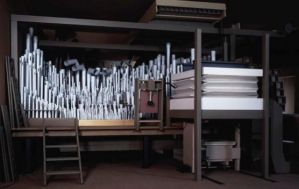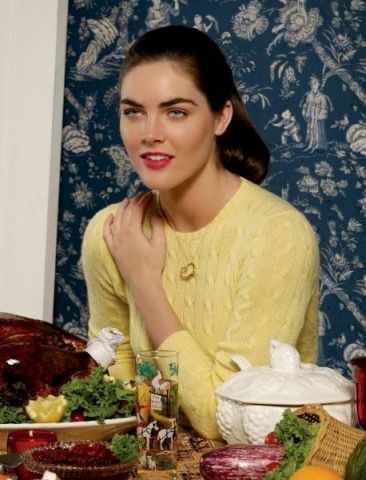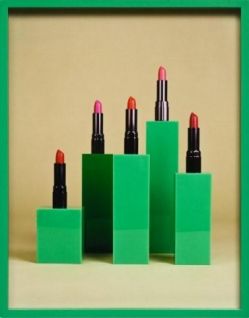Deutsche Börse Photography Prize 2011, Ambika P3 | reviews, news & interviews
Deutsche Börse Photography Prize 2011, Ambika P3
Deutsche Börse Photography Prize 2011, Ambika P3
From the punchy to the futile in photography's Turner Prize
You hardly expect to turn out for an exhibition of cutting-edge photography because of what the images are of. You go for the style, for the technique, for what’s being said about the medium and the, er, beauty. Yet at least one of the nominees for this year’s Deutsche Börse Photography Prize – an event that seems to be emerging as a kind of Turner Prize for photography – belongs to the old, subject-oriented approach to the lens. A member of the legendary Magnum agency, American Jim Goldberg is a photojournalist, who travels the world looking for bad stuff – torture, refugees, human trafficking. And if he doesn’t find enough of it he doesn’t eat.
Yet Goldberg’s photojournalism isn’t quite old school, as he allows, even encourages, his subjects – collaborators, he calls them – to intervene in his images: scrawling cryptic, sometimes harrowing messages and life stories on his prints and polaroids: "My dream is to go to Europe", "Taliban tortured me". The woman in The Famous Dancer Who Was Trafficked, Ukraine (main picture) has Tipp-Exed out her face. Images of the displaced, the exploited, the hopeful and without hope, in Ukraine, Liberia and Greece, in mixed scales and formats, form a beautifully arranged stream of consciousness – with movie images rotating on four screens – that leaves you feeling the whole world’s being tortured or trafficked in one way or another.
Yet looking at a picture of a little Senegalese girl standing on a pile of rubble you wonder what horrors lie behind it, before noting that the housing development in the background looks relatively middle class. Probably the image is wholly innocent, but everything is subsumed into Goldberg’s miserabilist vision.
The other three contestants are so elliptical in their messages, so fugitive in their effects, it’s difficult to know whether they look effete beside Goldberg’s punchy narrative or if they make him appear crude and over-literal.
 German Thomas Demand is well known as an artist who makes life-size and unnervingly realistic paper models of sites relevant to German history – often anonymous offices or bleak hotel rooms – which he photographs before discarding them. The photograph, also life-size, is the work. He often collaborates with architects, and here he presents a reconstruction of an installation created with British practice Caruso St John in which a photograph of an elaborate Austrian organ loft (pictured above right) is presented against a photographic backdrop of curtains. This single image, representing a real organ built by Austrian war veterans, achieves a certain monumentality, but Demand's one-concept work is all on one note. It’s not that they don’t need to be the size that they are, but if you've seen them in reproduction you can add the scale factor for yourself.
German Thomas Demand is well known as an artist who makes life-size and unnervingly realistic paper models of sites relevant to German history – often anonymous offices or bleak hotel rooms – which he photographs before discarding them. The photograph, also life-size, is the work. He often collaborates with architects, and here he presents a reconstruction of an installation created with British practice Caruso St John in which a photograph of an elaborate Austrian organ loft (pictured above right) is presented against a photographic backdrop of curtains. This single image, representing a real organ built by Austrian war veterans, achieves a certain monumentality, but Demand's one-concept work is all on one note. It’s not that they don’t need to be the size that they are, but if you've seen them in reproduction you can add the scale factor for yourself.

Californian Roe Ethridge engages in that most modish of current strategies: re-labelling. A skilled advertising photographer, he doesn’t so much moonlight as an artist as simply present his advertising imagery as art, generally without, but sometimes with, the written copy. Thanksgiving 1984 (pictured left), in which a pretty woman looks off-frame seated at a suburban dining table, is captured in a hyper-real, airless clarity that could be used to sell anything from face cream to knitting patterns. It generates a peculiar questioning quality. But Old Fruit, a bowl of rotting fruit presented as a contemporary memento mori, is the kind of thing we’ve seen before; in fact, Sam Taylor-Wood has done it, and it wasn’t that amazing then.
Fellow LA artist Elad Lassry plays on the fact that the photograph "as physical object has evaporated" in our digital age – which feels rich when you’re standing looking at something that looks very much like a physical object. Images that appear half-accidental or randomly selected – the shadow of a man on a beach, for example – alternate with carefully staged, quasi-sculptural pieces such as Lipstick (pictured below right), in which the handmade, colour-co-ordinated frames become part of the image. This is the kind of work that’s conventionally described as "witty", a word that dies on the lips as you speak it.
 Maybe it’s the way they’re hung – widely spaced in Ambika P3’s magnificent, but dauntingly large, brutalist basement – that makes Lassry and Ethridge’s images seem a shade underwhelming (next year the show will be back in the more suitably scaled Photographers' Gallery). Both artists look more intriguing in the catalogue, with a slightly different selection of images.
Maybe it’s the way they’re hung – widely spaced in Ambika P3’s magnificent, but dauntingly large, brutalist basement – that makes Lassry and Ethridge’s images seem a shade underwhelming (next year the show will be back in the more suitably scaled Photographers' Gallery). Both artists look more intriguing in the catalogue, with a slightly different selection of images.
Which brings us back to Jim Goldberg, who has found something more worthwhile to contemplate than the phenomenology of his medium's futility. And his images are often genuinely innovative. Demba’s Map, my favourite, shows a schematic map of the Sahara and southern Europe, consisting of arrows and points at which the eponymous creator was robbed of his money by police – all scrawled on the back of Goldberg’s photographs. The fact that this object contains hardly any of Goldberg’s imagery, and that his collaborator wasn’t a refugee but a people trafficker, lends it a disturbing ambiguity.
- Deutsche Börse Photography Prize 2011 at Ambika P3 until 1 May
 Find Jim Goldberg on Amazon
Find Jim Goldberg on Amazon
Explore topics
Share this article
more Visual arts
 Expressionists: Kandinsky, Münter and the Blue Rider, Tate Modern review - a missed opportunity
Wonderful paintings, but only half the story
Expressionists: Kandinsky, Münter and the Blue Rider, Tate Modern review - a missed opportunity
Wonderful paintings, but only half the story
 Eye to Eye: Homage to Ernst Scheidegger, MASI Lugano review - era-defining artist portraits
One of Switzerland's greatest photographers celebrated with a major retrospective
Eye to Eye: Homage to Ernst Scheidegger, MASI Lugano review - era-defining artist portraits
One of Switzerland's greatest photographers celebrated with a major retrospective
 Stephen review - a breathtakingly good first feature by a multi-media artist
Melanie Manchot's debut is strikingly intelligent and compelling
Stephen review - a breathtakingly good first feature by a multi-media artist
Melanie Manchot's debut is strikingly intelligent and compelling
 Fantastic Machine review - photography's story from one camera to 45 billion
Love it or hate it, the photographic image has ensnared us all
Fantastic Machine review - photography's story from one camera to 45 billion
Love it or hate it, the photographic image has ensnared us all
 Yinka Shonibare: Suspended States, Serpentine Gallery review - pure delight
Weighty subject matter treated with the lightest of touch
Yinka Shonibare: Suspended States, Serpentine Gallery review - pure delight
Weighty subject matter treated with the lightest of touch
 Jane Harris: Ellipse, Frac Nouvelle-Aquitaine MÉCA, Bordeaux review - ovals to the fore
Persistence and conviction in the works of the late English painter
Jane Harris: Ellipse, Frac Nouvelle-Aquitaine MÉCA, Bordeaux review - ovals to the fore
Persistence and conviction in the works of the late English painter
 Sargent and Fashion, Tate Britain review - portraiture as a performance
London’s elite posing dressed up to the nines
Sargent and Fashion, Tate Britain review - portraiture as a performance
London’s elite posing dressed up to the nines
 Zineb Sedira: Dreams Have No Titles, Whitechapel Gallery review - a disorientating mix of fact and fiction
An exhibition that begs the question 'What and where is home?'
Zineb Sedira: Dreams Have No Titles, Whitechapel Gallery review - a disorientating mix of fact and fiction
An exhibition that begs the question 'What and where is home?'
 Yoko Ono: Music of the Mind, Tate Modern review - a fitting celebration of the early years
Acknowledgement as a major avant garde artist comes at 90
Yoko Ono: Music of the Mind, Tate Modern review - a fitting celebration of the early years
Acknowledgement as a major avant garde artist comes at 90
 Unravel: The Power and Politics of Textiles in Art, Barbican review - the fabric of dissent
An ambitious exploration of a neglected medium
Unravel: The Power and Politics of Textiles in Art, Barbican review - the fabric of dissent
An ambitious exploration of a neglected medium
 When Forms Come Alive, Hayward Gallery review - how to reduce good art to family fun
Seriously good sculptures presented as little more than playthings or jokes
When Forms Come Alive, Hayward Gallery review - how to reduce good art to family fun
Seriously good sculptures presented as little more than playthings or jokes
 Entangled Pasts 1768-now, Royal Academy review - an institution exploring its racist past
After a long, slow journey from invisibility to agency, black people finally get a look in
Entangled Pasts 1768-now, Royal Academy review - an institution exploring its racist past
After a long, slow journey from invisibility to agency, black people finally get a look in

Add comment